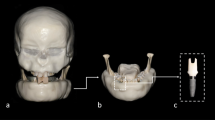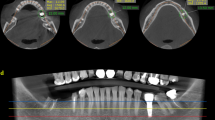Abstract
Objectives
This study aimed to evaluate the influence of the number of basis images and the metal artifact reduction (MAR) tool on the production of artifacts near and far from a zirconium implant in cone-beam computed tomography (CBCT).
Materials and methods
CBCT scans of a mandible were acquired before and after insertion of an implant, using 450 and 720 basis images, with and without MAR activation. The mean and standard deviation (SD) of the gray values of the regions of interest (ROIs) located on the cortices adjacent to the implant and at different distances from it (in the soft tissue) were calculated. The mean of the gray values was used to calculate the absolute contrast difference (ACD) between the control and implant scans.
Results
In general, the number of basis images did not affect the SD and the ACD values of the buccal and lingual ROIs (p > 0.05). The implant increased the SD in the lingual cortical plate (p < 0.05). In this case, MAR activation decreased SD (p < 0.05). All ROIs located at different distances from the implant showed higher SD on scans acquired with 450 basis images (p < 0.05), regardless of MAR condition.
Conclusions
A higher number of basis images reduces the magnitude of artifacts but does not influence the image quality in bone cortical plates. MAR improves the image in the areas most affected by artifacts.
Clinical relevance
The number of basis images is known as a factor capable of influencing the image quality and radiation dose for the patient. Therefore, it is important to investigate its effect on the expression of artifacts in the CBCT images.






Similar content being viewed by others
References
Jacobs R, Salmon B, Codari M, Hassan B, Bornstein MM (2018) Cone beam computed tomography in implant dentistry: recommendations for clinical use. BMC Oral Health 18:88. https://doi.org/10.1186/s12903-018-0523-5
Gjesteby L, De Man B, Jin Y, Paganetti H, Verburg J, Giantsoudi D, Wang G (2016) Metal artifact reduction in CT: where are we after four decades? IEEE Access 4:5826–5849. https://doi.org/10.1109/ACCESS.2016.2608621
Queiroz PM, Santaella GM, da Paz TD, Freitas DQ (2017) Evaluation of a metal artefact reduction tool on different positions of a metal object in the FOV. Dentomaxillofac Radiol 46:20160366. https://doi.org/10.1259/dmfr.20160366
Freitas DQ, Fontenele RC, Nascimento EHL, Vasconcelos TV, Noujeim M (2018) Influence of acquisition parameters on the magnitude of cone beam computed tomography artifacts. Dentomaxillofac Radiol 47:20180151. https://doi.org/10.1259/dmfr.20180151
Katsura M, Sato J, Akahane M, Kunimatsu A, Abe O (2018) Current and novel techniques for metal artifact reduction at CT: practical guide for radiologists. Radiographics 38:450–461. https://doi.org/10.1148/rg.2018170102
Nascimento EHL, Fontenele RC, Santaella GM, Freitas DQ (2019) Difference in the artefacts production and the performance of the metal artefact reduction (MAR) tool between the buccal and lingual cortical plates adjacent to zirconium dental implant. Dentomaxillofac Radiol 48:20190058. https://doi.org/10.1259/dmfr.20190058
Fontenele RC, Nascimento EH, Vasconcelos TV, Noujeim M, Freitas DQ (2018) Magnitude of cone beam CT image artifacts related to zirconium and titanium implants: impact on image quality. Dentomaxillofac Radiol 47:20180021. https://doi.org/10.1259/dmfr.20180021
Shokri A, Jamalpour MR, Khavid A, Mohseni Z, Sadeghi M (2019) Effect of exposure parameters of cone beam computed tomography on metal artifact reduction around the dental implants in various bone densities. BMC Med Imaging 19:34. https://doi.org/10.1186/s12880-019-0334-4
Gaêta-Araujo H, Nascimento EHL, Fontenele RC, Mancini AXM, Freitas DQ, Oliveira-Santos C (2020) Magnitude of beam-hardening artifacts produced by gutta-percha and metal posts on cone-beam computed tomography with varying tube current. Imaging Sci Dent 50:1–7. https://doi.org/10.5624/isd.2020.50.1.1
Queiroz PM, Groppo FC, Oliveira ML, Haiter-Neto F, Freitas DQ (2017) Evaluation of the efficacy of a metal artifact reduction algorithm in different cone beam computed tomography scanning parameters. Oral Surg Oral Med Oral Pathol Oral Radiol 123:729–734. https://doi.org/10.1016/j.oooo.2017.02.015
Nikbin A, Dalili Kajan Z, Taramsari M, Khosravifard N (2018) Effect of object position in the field of view and application of a metal artifact reduction algorithm on the detection of vertical root fractures on cone-beam computed tomography scans: an in vitro study. Imaging Sci Dent 48:245–254. https://doi.org/10.5624/isd.2018.48.4.245
Rosado LPL, Fagundes FB, Freitas DQ, Oliveira ML, Neves FS (2020) Influence of the intracanal material and metal artifact reduction tool in the detection of the second mesiobuccal canal in cone-beam computed tomographic examinations. J Endod 46:1067–1073. https://doi.org/10.1016/j.joen.2020.04.011
Costa ED, Brasil DM, Queiroz PM, Verner FS, Junqueira RB, Freitas DQ (2020) Use of the metal artefact reduction tool in the identification of fractured endodontic instruments in cone-beam computed tomography. Int Endod J 53:506–512. https://doi.org/10.1111/iej.13242
Sheikhi M, Behfarnia P, Mostajabi M, Nasri N (2020) The efficacy of metal artifact reduction (MAR) algorithm in cone-beam computed tomography on the diagnostic accuracy of fenestration and dehiscence around dental implants. J Periodontol 91:209–214. https://doi.org/10.1002/JPER.18-0433
Kamburoğlu K, Yılmaz F, Yeta EN, Özen D (2016) Assessment of furcal perforations in the vicinity of different root canal sealers using a cone beam computed tomography system with and without the application of artifact reduction mode: an ex vivo investigation on extracted human teeth. Oral Surg Oral Med Oral Pathol Oral Radiol 121:657–665. https://doi.org/10.1016/j.oooo.2016.01.010
Queiroz PM, Santaella GM, Groppo FC, Freitas DQ (2018) Metal artifact production and reduction in CBCT with different numbers of basis images. Imaging Sci Dent 48:41–44. https://doi.org/10.5624/isd.2018.48.1.41
Pauwels R, Stamatakis H, Bosmans H et al (2013) Quantification of metal artifacts on cone beam computed tomography images. Clin Oral Implants Res 24(Suppl A100):94–99. https://doi.org/10.1111/j.1600-0501.2011.02382.x
Schulze R, Heil U, Gross D, Bruellmann DD, Dranischnikow E, Schwanecke U, Schoemer E (2011) Artefacts in CBCT: a review. Dentomaxillofac Radiol 40:265–273. https://doi.org/10.1259/dmfr/30642039
Pauwels R, Faruangsaeng T, Charoenkarn T, Ngonphloy N, Panmekiate S (2015) Effect of exposure parameters and voxel size on bone structure analysis in CBCT. Dentomaxillofac Radiol 44:20150078. https://doi.org/10.1259/dmfr.20150078
Katkar R, Steffy DD, Noujeim M, Deahl ST 2nd, Geha H (2016) The effect of milliamperage, number of basis images, and export slice thickness on contrast-to-noise ratio and detection of mandibular canal on cone beam computed tomography scans: an in vitro study. Oral Surg Oral Med Oral Pathol Oral Radiol 122(5):646–653. https://doi.org/10.1016/j.oooo.2016.08.006
Nascimento MDCC, Boscolo SMA, Haiter-Neto F, Santos ECD, Lambrichts I, Pauwels R, Jacobs R (2017) Influence of basis images and skull position on evaluation of cortical bone thickness in cone beam computed tomography. Oral Surg Oral Med Oral Pathol Oral Radiol 123(6):707–713. https://doi.org/10.1016/j.oooo.2017.01.015
Lagos de Melo LP, Oenning ACC, Nadaes MR, Nejaim Y, Neves FS, Oliveira ML, Freitas DQ (2017) Influence of acquisition parameters on the evaluation of mandibular third molars through cone beam computed tomography. Oral Surg Oral Med Oral Pathol Oral Radiol 124(2):183–190. https://doi.org/10.1016/j.oooo.2017.03.008
Kamburoglu K, Kolsuz E, Murat S, Eren H, Yüksel S, Paksoy CS (2013) Assessment of buccal marginal alveolar peri-implant and periodontal defects using a cone beam CT system with and without the application of metal artefact reduction mode. Dentomaxillofac Radiol 42:20130176. https://doi.org/10.1259/dmfr.20130176
de-Azevedo-Vaz SL, Peyneau PD, Ramirez-Sotelo LR, de F Vasconcelos K, Campos PS, Haiterneto F (2016) Efficacy of a cone beam computed tomography metal artifact reduction algorithm for the detection of peri-implant fenestrations and dehiscences. Oral Surg Oral Med Oral Pathol Oral Radiol 121:550–556. https://doi.org/10.1016/j.oooo.2016.01.013
Freitas DQ, Nascimento EHL, Vasconcelos TV, Noujeim M (2019) Diagnosis of external root resorption in teeth close and distant to zirconium implants: influence of acquisition parameters and artefacts produced during cone beam computed tomography. Int Endod J 52:866–873. https://doi.org/10.1111/iej.13065
Freitas DQ, Vasconcelos TV, Noujeim M (2019) Diagnosis of vertical root fracture in teeth close and distant to implant: an in vitro study to assess the influence of artifacts produced in cone beam computed tomography. Clin Oral Investig 23:1263–1270. https://doi.org/10.1007/s00784-018-2558-z
Gaêta-Araujo H, Alzoubi T, Vasconcelos KF, Orhan K, Pauwels R, Casselman JW, Jacobs R (2020) Cone beam computed tomography in dentomaxillofacial radiology: a two-decade overview. Dentomaxillofac Radiol 49:20200145. https://doi.org/10.1259/dmfr.20200145
Große Hokamp N, Eck B, Siedek F, Pinto Dos Santos D, Holz JA, Maintz D, Haneder S (2020) Quantification of metal artifacts in computed tomography: methodological considerations. Quant Imaging Med Surg 10:1033–1044. https://doi.org/10.21037/qims.2020.04.03
Funding
This study was financed in part by the Coordenação de Aperfeiçoamento de Pessoal de Nível Superior—Brazil (CAPES)—Finance Code 001.
Author information
Authors and Affiliations
Corresponding author
Ethics declarations
Ethics approval
This study design was approved by the local Institutional Ethics Committee under protocol number #70218017.4.0000.5418, and with the 1964 Helsinki declaration and its later amendments or comparable ethical standards.
Informed consent
Formal consent in not applicable for this type of research.
Conflict of interest
The authors declare no conflict of interest.
Additional information
Publisher’s note
Springer Nature remains neutral with regard to jurisdictional claims in published maps and institutional affiliations.
Rights and permissions
About this article
Cite this article
Nascimento, E.H.L., Gaêta-Araujo, H., Fontenele, R.C. et al. Do the number of basis images and metal artifact reduction affect the production of artifacts near and far from zirconium dental implants in CBCT?. Clin Oral Invest 25, 5281–5291 (2021). https://doi.org/10.1007/s00784-021-03836-5
Received:
Accepted:
Published:
Issue Date:
DOI: https://doi.org/10.1007/s00784-021-03836-5




